TSGR7001-2004 压力容器定期检验规则
TSGR7001-压力容器定期检验规则

TSG特种设备安全技术规范 TSG R7001-2013压力容器定期检验规则Pressure Vessel Periodical Inspection Regulation中华人民共和国国家质量监督检验检疫总局颁布2013年1月16日前言2009年11月,国家质量监督检验检疫总局(以下简称国家质检总局)特种设备安全监察局(以下简称特种设备局)下达修订《压力容器定期检验规则》(以下简称定检规)的任务书,2010年1月,中国特种设备检测研究院(以下简称中国特检院)组织有关专家成立修订工作组,在北京召开第一次会议,讨论定检规修订的原则、重点内容及主要问题,并且就修订工作进行了具体分工,制定了修订工作时间表。
2010年5月,工作组在合肥召开了第二次会议,经过讨论,形成了定检规征求意见稿。
2010年6月,特种设备局以质检特}[2010]31号文征求意见。
2010年10月,工作组根据征求的意见,研究处理形成送审稿。
在修订过程中,特种设备局还多次.与工作组召开专题会议,研讨定检规修订过程中的重大问题。
2010年11月,特种设备局将送审稿提交给国家质检总局特种设备安全技术委员会审议,工作组根据审议意见修改后形成了报批稿。
2013年1月16日,本规则由国家质检总局批准颁布。
本次修订工作的基本原则,与《特种设备安全监察条例》、《固定式压力容器安全技术监察规程》(TSG 80004)和《移动式压力容器安全技术监察规程》(TSG 80005)协调一致;根据5年来的实际使用情况以及行业发展,调整、完善不适应的内容,新增加附件E非金属及非金属衬里压力容器定期检验专项要求;明确定期检验的性质、定位及检验周期的含义,按国家质检总局及信息化工作要求,统一检验结论及结论报告内容;理清使用单位、,检验机构、监察机构的义务;明确检验机构、检验人员的义务与分工;在考虑基本安全要求的基础上,建立基于损伤模式、失效模式制定针对性检验方案的思想,突出检验项目的针对性、有效性、科学性;为新检验检测技术、评定方法的应用,给出渠道;吸纳成熟的科技成果,理清与常规检验方法的关系;方便企业,服务于企业的发展;兼顾国际发展,具有中国特色;安全技术规范与相应标准协调一致,为在用设备检验标准的制定留出接口。
TSG R7001压力容器定期检验规则
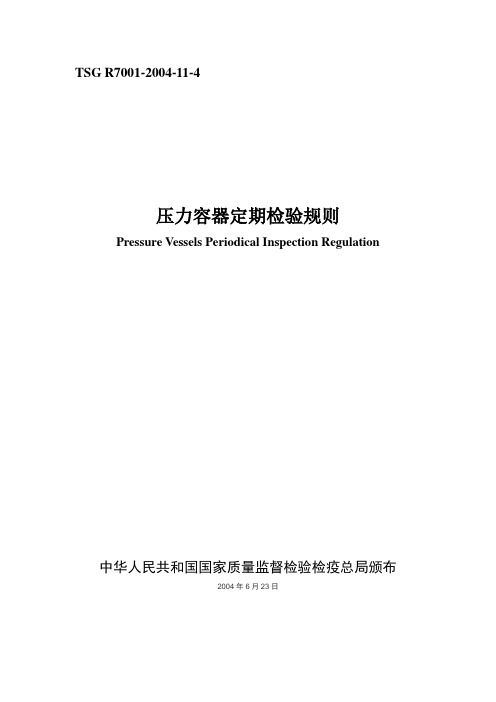
TSG R7001-2004-11-4压力容器定期检验规则Pressure Vessels Periodical Inspection Regulation中华人民共和国国家质量监督检验检疫总局颁布2004年6月23日目录第一章总则 (1)第二章年度检查 (3)第三章全面检验 (9)第四章耐压试验 (17)第五章安全状况等级评定 (19)第六章附则 (24)附件一移动式压力容器定期检验附加要求 (26)附件二医用氧舱定期检验要求 (34)附件三安全阀校验要求 (47)附录1 压力容器年度检查报告 (52)附录2 压力容器全面检验报告 (55)附录3 耐压试验报告 (75)附录4 特种设备检验意见通知书 (76)压力容器定期检验规则第一章总则第一条为了保证在用压力容器定期检验工作的质量,确保压力容器安全运行,防止事故发生,根据《特种设备安全监察条例》、《压力容器安全技术监察规程》(以下简称《容规》)的有关规定,制定本规则。
第二条本规则适用于属于《容规》适用范围的压力容器的年度检查和定期检验。
其中,在用罐车(以下简称罐车)、在用罐式集装箱(以下简称罐式集装箱)的年度检查和定期检验,除符合本规则正文的有关要求外,还应当遵照本规则附件一《移动式压力容器定期检验附加要求》的规定。
第三条年度检查,是指为了确保压力容器在检验周期内的安全而实施的运行过程中的在线检查,每年至少一次。
固定式压力容器的年度检查可以由使用单位的压力容器专业人员进行,也可以由国家质量监督检验检疫总局(以下简称国家质检总局)核准的检验检测机构(以下简称检验机构)持证的压力容器检验人员进行。
第四条压力容器定期检验工作包括全面检验和耐压试验。
(一)全机检验是指压力容器停机时的检验。
全面检验应当由检验机构进行。
其检验周期为:1、安全状况等级为1、2级的,一般每6年一次;2、安全状况等级为3级的,一般3~6年一次;3、安全状况等级为4级的,其检验周期由检验机构确定。
TSG R7001-2004-压力容器定期检验规则
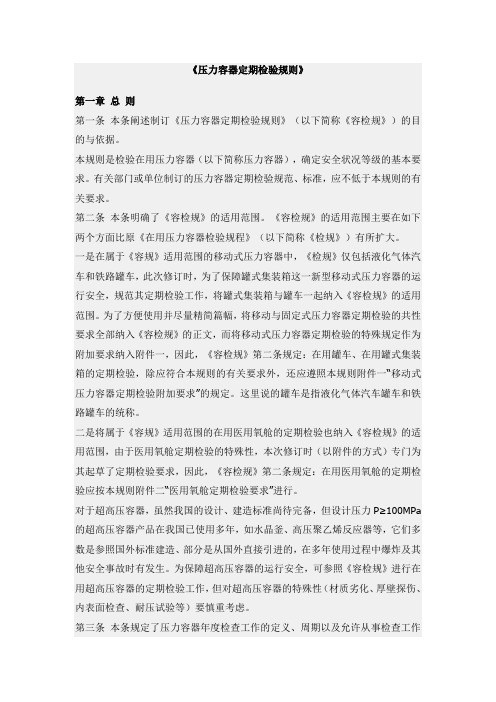
《压力容器定期检验规则》第一章总则第一条本条阐述制订《压力容器定期检验规则》(以下简称《容检规》)的目的与依据。
本规则是检验在用压力容器(以下简称压力容器),确定安全状况等级的基本要求。
有关部门或单位制订的压力容器定期检验规范、标准,应不低于本规则的有关要求。
第二条本条明确了《容检规》的适用范围。
《容检规》的适用范围主要在如下两个方面比原《在用压力容器检验规程》(以下简称《检规》)有所扩大。
一是在属于《容规》适用范围的移动式压力容器中,《检规》仅包括液化气体汽车和铁路罐车,此次修订时,为了保障罐式集装箱这一新型移动式压力容器的运行安全,规范其定期检验工作,将罐式集装箱与罐车一起纳入《容检规》的适用范围。
为了方便使用并尽量精简篇幅,将移动与固定式压力容器定期检验的共性要求全部纳入《容检规》的正文,而将移动式压力容器定期检验的特殊规定作为附加要求纳入附件一,因此,《容检规》第二条规定:在用罐车、在用罐式集装箱的定期检验,除应符合本规则的有关要求外,还应遵照本规则附件一“移动式压力容器定期检验附加要求”的规定。
这里说的罐车是指液化气体汽车罐车和铁路罐车的统称。
二是将属于《容规》适用范围的在用医用氧舱的定期检验也纳入《容检规》的适用范围,由于医用氧舱定期检验的特殊性,本次修订时(以附件的方式)专门为其起草了定期检验要求,因此,《容检规》第二条规定:在用医用氧舱的定期检验应按本规则附件二“医用氧舱定期检验要求”进行。
对于超高压容器,虽然我国的设计、建造标准尚待完备,但设计压力P≥100MPa 的超高压容器产品在我国已使用多年,如水晶釜、高压聚乙烯反应器等,它们多数是参照国外标准建造、部分是从国外直接引进的,在多年使用过程中爆炸及其他安全事故时有发生。
为保障超高压容器的运行安全,可参照《容检规》进行在用超高压容器的定期检验工作,但对超高压容器的特殊性(材质劣化、厚壁探伤、内表面检查、耐压试验等)要慎重考虑。
TSG特种设备安全技术规范-压力容器定期检验规则
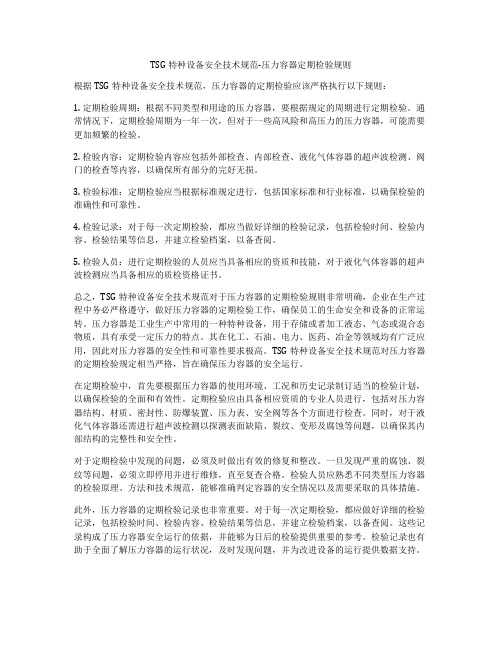
TSG特种设备安全技术规范-压力容器定期检验规则根据TSG特种设备安全技术规范,压力容器的定期检验应该严格执行以下规则:1. 定期检验周期:根据不同类型和用途的压力容器,要根据规定的周期进行定期检验。
通常情况下,定期检验周期为一年一次,但对于一些高风险和高压力的压力容器,可能需要更加频繁的检验。
2. 检验内容:定期检验内容应包括外部检查、内部检查、液化气体容器的超声波检测、阀门的检查等内容,以确保所有部分的完好无损。
3. 检验标准:定期检验应当根据标准规定进行,包括国家标准和行业标准,以确保检验的准确性和可靠性。
4. 检验记录:对于每一次定期检验,都应当做好详细的检验记录,包括检验时间、检验内容、检验结果等信息,并建立检验档案,以备查阅。
5. 检验人员:进行定期检验的人员应当具备相应的资质和技能,对于液化气体容器的超声波检测应当具备相应的质检资格证书。
总之,TSG特种设备安全技术规范对于压力容器的定期检验规则非常明确,企业在生产过程中务必严格遵守,做好压力容器的定期检验工作,确保员工的生命安全和设备的正常运转。
压力容器是工业生产中常用的一种特种设备,用于存储或者加工液态、气态或混合态物质,具有承受一定压力的特点。
其在化工、石油、电力、医药、冶金等领域均有广泛应用,因此对压力容器的安全性和可靠性要求极高。
TSG特种设备安全技术规范对压力容器的定期检验规定相当严格,旨在确保压力容器的安全运行。
在定期检验中,首先要根据压力容器的使用环境、工况和历史记录制订适当的检验计划,以确保检验的全面和有效性。
定期检验应由具备相应资质的专业人员进行,包括对压力容器结构、材质、密封性、防爆装置、压力表、安全阀等各个方面进行检查。
同时,对于液化气体容器还需进行超声波检测以探测表面缺陷、裂纹、变形及腐蚀等问题,以确保其内部结构的完整性和安全性。
对于定期检验中发现的问题,必须及时做出有效的修复和整改。
一旦发现严重的腐蚀、裂纹等问题,必须立即停用并进行维修,直至复查合格。
压力容器定期检验规则(TSGR7001-)
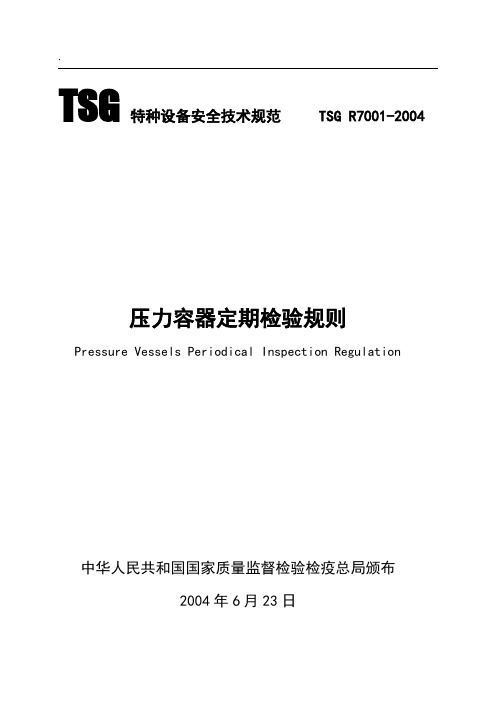
(四)准备好压力容器安全管理规章制度和安全操作规范,操作人员的资格证;
(五)检查时,使用单位压力容器管理人员和相关人员到场配合,协助检查工作,及时提供检查人员需要的其他资料。
第十三条检查前检查人员应当首先全面了解被检压力容器的使用情况、管理情况,认真查阅压力容器技术档案资料和管理资料,做好有关记录。
5.停止使用时间超过2年的;
6.改变使用介质并且可能造成腐蚀现象恶化的;
7.设计图样注明无法进行耐压试验的;
8.检验中对其他影响安全的因素有怀疑的;
9.介质为液化石油气且有应力腐蚀现象的,每年或根据需要进行全面检验;
10.采用“亚铵法”造纸工艺,且无防腐措施的蒸球根据需要每年至少进行一次全面检验;
11.球形储罐(使用标准抗拉强度下限бb≥540MPa材料制造的,投用一年后应当开罐检验);
(1)选型错误;
(2)表盘封面玻璃破裂或者表盘刻度模糊不清;
(3)封印损坏或者超过检定有效期限;
(4)表内弹簧管泄漏或者压力表指针松动;
(5)指针扭曲断裂或者外壳腐蚀严重;
(6)通旋塞或者针形阀开启标记不清或者锁紧装置损坏。
(二)液位计
1.液位计年度检查,至少包括以下内容:
(1)液位计的定期检修维护制度;
当全面检验、耐压试验和年度检查在同一年度进行时,应当依次进行全面检验、耐压试验和年度检查,其中全面检验已经进行的项目,年度检查时不再重复进行。
对无法进行或者无法按期进行全面检验、耐压试验的压力容器,按照《容规》第138条规定执行。
第五条压力容器一般应当于投用满3年时进行首次全面检验。下次的全面检验周期,由检验机构根据本次全面检验结果按照本规则第四条的有关规定确定。
TSG特种设备安全技术规范-压力容器定期检验规则(30)(1)
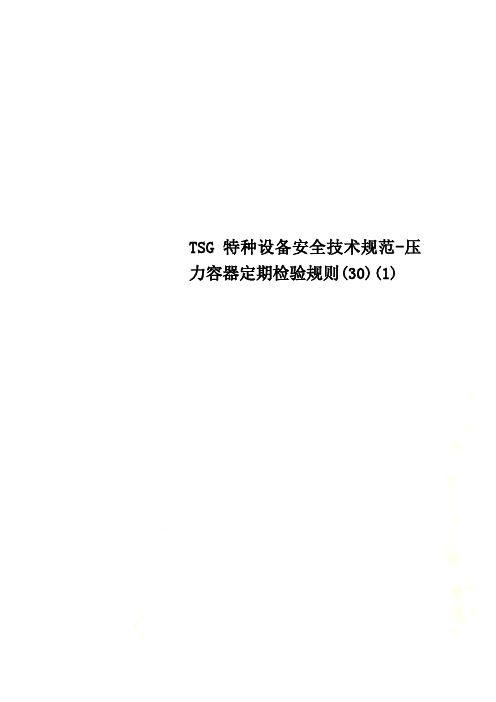
TSG特种设备安全技术规范-压力容器定期检验规则(30)(1)TSG特种设备安全技术规范 TSG R7001-2004压力容器定期检验规则Pressure Vessels Periodical Inspection Regulation中华人民共和国国家质量监督检验检疫总局颁布2004年6月23日目录TSG 特种设备安全技术规范 TSG R7001-2004·· 0压力容器定期检验规则第一章总则第一条为了保证在用压力容器定期检验工作的质量,确保压力容器安全运行,防止事故发生,根据《特种设备安全监察条例》、《压力容器安全技术监察规程》(以下简称《容规》)的有关规定,制定本规则。
第二条本规则适用于属于《容规》适用范围的压力容器的年度检查和定期检验。
其中,在用罐车(以下简称罐车)、在用罐式集装箱(以下简称罐式集装箱)的年度检查和定期检验,除符合本规则正文的有关要求外,还应当遵照本规则附件一《移动式压力容器定期检验附加要求》的规定。
在用医用氧舱(以下简称医用氧舱)的年度检查和定期检验应当按本规则附件二《医用氧舱定期检验要求》进行。
第三条年度检查,是指为了确保压力容器在检验周期内的安全而实施的运行过程中的在线检查,每年至少一次。
固定式压力容器的年度检查可以由使用单位的压力容器专业人员进行,也可以由国家质量监督检验检疫总局(以下简称国家质检总局)核准的检验检测机构(以下简称检验机构)持证的压力容器检验人员进行。
第四条压力容器定期检验工作包括全面检验和耐压试验。
(一)全面检验是指压力容器停机时的检验。
全面检验应当由国家质检总局核准的检验机构进行。
其检验周期为:1.安全状况等级为1、2级的,一般每6年一次;2.安全状况等级为3级的,一般3~6年一次;3.安全状况等级为4级的,其检验周期由检验机构确定。
压力容器安全状况等级的评定按本规则第五章进行。
(二)耐压试验是指压力容器全面检验合格后,所进行的超过最高工作压力的液压试验或者气压试验。
电梯检验规程TSG T7001-2004

TSG特种设备安全技术规范TSG T7001-2004电梯安装监督检验与定期检验规则Elevator Installation Supervision Inspectionand Periodicity Inspection Regulation(征求意见稿)中华人民共和国国家质量监督检验检疫总局颁布2004年月日目录电梯安装监督检验及定期检验规则 (1)附件 1 电梯安装监督检验与定期检验必备检验检测仪器设备表 (7)附件 2 电梯安装监督检验与定期检验内容、要求与方法 (8)附件 3 曳引驱动式电梯安装监督检验报告 (29)附件 4 曳引驱动式电梯定期检验报告 (30)附件 5 无机房电梯安装监督检验报告 (35)附件 6 无机房电梯定期检验报告 (41)附件 7 强制驱动式电梯安装监督检验报告 (46)附件 8 强制驱动式电梯定期检验报告 (52)附件 9 特种设备检验意见通知书 (68)电梯安装监督检验及定期检验规则第一条为了加强对电梯安装、改造、重大维修过程的监督检验(以下简称安装监督检验)和定期检验工作的管理,规范电梯安装监督检验和定期检验的行为,提高检验工作质量,根据《特种设备安全监察条例》的有关规定,制定本规则。
第二条本规则所称安装监督检验是指电梯在在安装(包括异地重装,下同)、改造、重大维修过程中,由国家质量监督检验检疫总局(以下简称国家质检总局)核准的特种设备检验检测机构(以下简称检验机构),根据法规以及本规则规定对其进行的强制性检验;本规则所称定期检验是指检验机构根据法规以及本规则规定,对在用电梯定期进行的强制性检验。
第三条从事电梯的安装监督检验和在用电梯的定期检验,应当遵守本规则规定的检验内容、要求和方法。
如果采用与本规则不一致的检验方法,必须经过国家质检总局同意。
本规则不适用于液压电梯、防爆电梯、杂物电梯、自动扶梯和自动人行道的安装监督检验和定期检验。
第四条本规则的技术指标和要求主要引用了GB 7588─2003《电梯制造与安装安全规范》等有关国家标准的规定。
英文-TSG R7001-2004压力容器定期检验规则

TSG特种设备安全技术规范TSG Safety Technical Specification for Special EquipmentTSG R7001-2004压力容器定期检验规则Pressure Vessels Periodical Inspection RegulationIssued by State General Bureau of Quality Supervision, Inspection and Quarantine of the People’s Republic of ChinaJune 23, 2004ContentsChapter 1 General (3)Chapter 2 Annual Examination (6)Chapter 3 Overall Inspection (14)Chapter 4 Pressure Resistance Test (25)Chapter 5 Evaluation of Class of safety Status (29)Chapter 6 Supplementary Provisions (36)Appendix I Additional Requirement for Periodical Inspection of Movable Pressure Vessels (38)Appendix II Requirement for Periodical Inspection of Medical Use Oxygen Cabin (48)Appendix III Requirement for Calibration of Safety V alves (63)Annex I Annual Examination Report on Pressure V essels (69)Annex II Overall Inspection Report on Pressure V essels (72)Annex III Report on Pressure Resistance Test (92)Annex IV Notice of Comments on Inspection of Special Equipment (1) (93)Pressure Vessels Periodical Inspection RegulationChapter 1 GeneralArticle 1 To guarantee the quality of periodical inspection of in-use pressure vessels and to secure safe running of pressure vessels as well as to avoid occurrence of any accident, this regulation is worked out in accordance with the Safety Supervision Regulation for Special Equipment and Safety Technical Supervision Regulation for Pressure Vessels (hereinafter referred to as RPV).Article 2 This regulation applies to annual examination and periodical inspection of pressure vessels within the scope of application of pressure vessels, annual examination and periodical inspection of in-use truck tanks (hereinafter referred to as truck tanks) and in-use tank containers (hereinafter referred to as tank containers) shall, apart from compliance with relevant requirements in the text of this regulation, also follow what specified in Appendix I of this regulation the Additional Requirement for Periodical Inspection of Movable Pressure Vessels.For annual examination and periodical inspection of in-use medical oxygen cabins (hereinafter referred to as oxygen cabins for medical use, abbreviated as MUOC), Appendix II of this regulation the Requirement for Periodical Inspection of Oxygen cabins for medical use shall apply.Article 3 Annual examination is the in-line examination during the running to secure the safety of pressure vessels within the inspection interval, which shall be done at least one a year. Annual examination of fixed pressure vessels may be done either by pressure vessel professional personnel of the user organization, or by certified pressure vessel inspection personnel of inspection organization (hereinafter referred to as inspection organization, abbreviated as IO) which is approved by the State General Bureau of Quality Supervision, Inspection and Quarantine (hereinafter referred to as SGBQI).Article 4 Periodical inspection of pressure vessels includes overall inspection and pressure resistance test.1. Overall inspection is the inspection at the halt of pressure vessels, which shall be done byIO. The inspection interval shall be:(1) For pressure vessels with safety status of Class 1 or Class 2, in general, it shall beonce 6 years;(2) For pressure vessels with safety status of Class 3, in general, it shall be once 3 ~ 6years;(3) For pressure vessels with safety status of Class 4, in general, it shall be determinedby IO.The evaluation of safety status of pressure vessels shall be done in accordance with Chapter 5 of this regulation.2. Pressure resistance test is the hydraulic test or air pressure test at pressure exceeding max.working pressure done after qualification of overall inspection of pressure vessels. In principle, within the period of two overall inspections, one pressure resistance test shall be done.In case the overall inspection, pressure resistance test and annual examination are done in same year, the sequence shall be overall inspection, pressure resistance test and annual examination, the items which have been overall inspected may not be examined in annual examination repeatedly.For pressure vessels for which overall inspection and pressure resistance test cannot be done or cannot be done in schedule, Article 138 of RPV shall apply.Article 5 First overall inspection shall be done to pressure vessels which have been put into operation for 3 years. The next overall inspection interval shall be determined by IO according to the results of this inspection based on relevant stipulations of Article 4 of this regulation.1. Overall inspection interval for pressure vessels of any of following cases shall beshortened appropriately:(1) The corrosion of medium to vessel material is not clear or the annual corrosion rateof medium to material is > 0.25mm, or the corrosion data determined by designer is not in conformity with actual condition;(2) The surface quality of material is bad or there is internal defects;(3) Application condition is severe or stress corrosion is found in application;(4) The application term exceeds 20 years and it is determined by inspectors or bytechnical verification that the normal inspection interval cannot secure the safe application;(5) The application is stopped for more than 2 years;(6) Medium is changed and there is possibility of worse corrosion;(7) Design drawing shows that pressure resistance test can not be made;(8) During the inspection, other factors affecting safety are doubtable;(9) Medium is LPG and there is stress corrosion, overall inspection shall be made everyyear or on necessary;(10) In case the process is used to make paper and no anti-corrosion measures are taken,overall inspection shall be made at least once a year for steam balls;(11) Spherical tanks (made of material of lower limit of standard tensile strength σb≥540Mpa, open tank inspection shall be made to them after putting into operation for one year.);(12) E quipment of glass lining.2. Overall inspection interval for pressure vessels with safety status of Class 1 or Class 2 ofany of following cases shall be shortened appropriately:(1) Inspection interval for those of good non-metal lining can be prolonged to 9 years;(2) In case the corrosion rate of medium to material is < 0.1mm (actually measured data)and there is reliable corrosion resistance metal lining(composite steel plate)or hot-sprayed metal coat (aluminum powder or stainless steel) and it is confirmed after1 ~2 overall inspections that the corrosion is light or the lining is good, theinspection interval can be prolonged to 12 years;(3) For reactors filled with catalyst and large pressure vessels packed with fillingmaterial, the inspection interval shall be determined by user organization, designer and IO after discussion in accordance with design drawings and actual application conditions, which shall be reported to the quality technical supervision department where the Application Register Card was applied and obtained (hereinafter referred to as Certificate Issuing Organ, abbreviated as CIO) for record.Article 6 The accumulated application time for pressure vessels under monitoring with safety status of Class 4 shall not exceed 3 years. During the app lication period under monitoring, defects shall be treated to raise the class of safety status , otherwise they shall not be used further.Article 7 Pressure resistance test shall be made after overall inspection to pressure vessels of any of following cases is made and qualified:1. Pressure elements are replaced by the way of welding;2. The depth of remedy welding for pressure element is > 1/2 wall thickness;3. Application condition is changed and the original design parameters are exceeded andafter strength verification, it is qualified;4. Those needing lining replacement (pressure resistance test shall be done before liningreplacement);5. Application is resumed after 2 years’ stoppage;6. It is replanted from external organization or from same organization;7. The user organization or IO has doubt about the safety status of the pressure vessel.Article 8 IO and inspectors engaging in periodical inspection of pressure vessels shall makeinspection strictly in accordance with the scope of inspection approved. IO and inspectors shall accept supervision of local quality technical supervision department and shall be responsible for the correctness of the results of periodical inspection of pressure vessels.Prior to the inspection, IO shall work out inspection scheme, which shall be checked and approved by technical responsible person authorized by IO. For inspection scheme for pressure vessels of special requirements, IO shall solicit opinion of user organization and original designer. In case of any discrepancy, the opinion of IO shall apply. Inspectors shall make inspection strictly in accordance with the approved inspection scheme.Article 9 User organization shall apply for periodical inspection of pressure vessels 30 days in advance the expiration date of inspection validity, meanwhile the application form for pressure vessels inspection shall be submitted to IO and CIO. IO shall fulfill inspection in accordance with inspection plan.Article 10 User organization shall closely cooperate with IO and well do the technical treatment after halt as well as safety checks before inspection in accordance with this regulation. Inspection shall not start until it is confirmed that it meets requirements for inspection. They shall also provide cooperation at inspection site.Chapter 2 Annual ExaminationArticle 11Annual examination of pressure vessels includes examination of safety management of pressure vessels by user organization, examination of pressure vessels themselves and their running status as well as examination of safety accessories of pressure vessels.The way of examination shall be mainly the macro examination, if necessary, thickness measuring, examination of wall temperature and measurement of content of corrosive medium as well as test of vacuum shall be made.Article 12 Prior to annual examination, user organization shall make following preparation ready:1. Cleaning of outer surface and environment of pressure vessels;2. Site lighting, protection for high position climbing and removal of local insulation shallbe done to meet the need of site examination;3. Technical files, running records as well as records of harmful impurities used for pressurevessels shall be ready;4. Regulations for safety management of pressure vessels as well as regulations for safetyoperation and certificates of operators shall be ready;5. During examination, management personnel and relevant personnel for pressure vesselsof user organization shall be present to assist examination and provide other informationexaminers needed.Article 13Before examination, examiners shall have an overall understanding of use condition and management condition of pressure vessels to be examined and seriously review technical files and management information of pressure vessels and relevant records shall be made.The examination of safety management conditions of pressure vessels shall include followings:1. Regulations for safety management and regulations for safety operation of pressurevessels, whether records are complete and true, look over desk exercises (or accounting books) of pressure vessels to be sure they are in conformity with actual condition;2. Examine file documents of drawings, application register cards, product qualitycertificates, instructions, supervision and inspection certificates, annual inspection reports in history, documents of reconstruction to be sure whether they are complete and meet requirements.3. Whether operators of pressure vessels are working in posts with certificate;4. Are issues referred in last inspection and examination reports solved?Article 14 For examination of pressure vessels themselves and their running condition, in general, insulation may not be removed unless required by examiners.Article 15 Examination of pressure vessels themselves and their running condition shall include followings:1. Whether the nameplate, color of painting, marks as well as painted application cardnumber meet relevant regulation?2. Whether there are crack, overheat, deformation, leakage or damage in the body,connecting places (valves, piping) and welding joints of pressure vessels;3. Whether there are damage, abnormal, frosting or dewing in outside surface;4. Whether there are damage, peeling off, damping or cold leakage of insulation;5. Whether there are liquid leakage or air leakage from leakage inspection holes or signalholes and whether leakage inspection holes are unimpeded;6. Whether there are abnormal vibration or abnormal sound or mutual friction betweenpressure vessels and adjoining piping or elements;7. Whether there is damage to supports or supporting seats, whether there are settlement,inclination, crack in foundation, whether fastening bolts are complete and in good order;8. Whether draining facilities (traps, drainage) are good;9. Whether there are over pressure, over temperature or over quantity during running;10. Whether earthing for tanks needing earthing meet requirements;11. The implementation of measures for those pressure vessels with safety status class ofClass 4 under monitoring and whether there is any abnormal situation;12. Whether safety-interlocking devices for pressure vessels of quick-open door meetsrequirements.Article 16 Inspection of safety accessories includes examination and calibration of pressure gauges, level gauges, temperature measuring instruments, disrupture disk devices and safety valves (for calibration requirements of safety valves, see Appendix III).1. Pressure gauges(1) Annual examination of pressure gauges shall at least include followings:(a) Type selection of pressure gauges;(b) Rules for periodical inspection and maintenance of pressure gauges, validity ofverification and the seal;(c) Appearance, class of precision, scale range and diameter of panel of pressuregauges;(d) The position, marks for opening as well as interlocking devices of T plugs andneedle valves installed between pressure vessels and pressure gauges;(e) Whether readings of pressure gauges in same system are same.(2) During annual examination, for any of following cases found, user organization shallbe asked to rectify them within limited time and effective measures shall be taken to secure the safe during the rectification period. In case they are not corrected beyond the time, the use of that pressure vessels shall be stopped temporarily:(a) Wrong selection of type;(b) Panel cover glass is broken or scale of graduation in panel is not clear;(c) Lead seal is damaged or it is beyond validity of verification;(d) There is leakage in the spring tube in instrument or the indicating hand ofpressure gauge is loose;(e) Indicating hand is tortured or broken or outer housing is seriously corroded;(f) Marks for opening of T plug or needle valves are not clear or the locking deviceis damaged.2. Level gauges(1) Annual examination of level gauges shall at least include followings:(a) Rules for periodical inspection and maintenance of level gauges;(b) Appearance and accessories of level gauges;(c) Selection of type of level gauges outdoor used in cold areas or fully filled withmedium with temperature below 0℃;(d) Protection device from leakage of level gauges used in pressure vessels forliquefied gases with flammable medium of toxicity degree of extreme and highhazard.(2) During examination, for any of following cases found, user organization shall beasked to rectify them within limited time and effective measures shall be taken to secure the safe during the rectification period. In case they are not corrected beyond the time, the use of that pressure vessels shall be stopped temporarily:(a) Inspection and maintenance period is beyond the specified period;(b) There is crack or break in glass plate (tube);(c) V alve elements are dead;(d) There is false level;(e) Indication of level gauge is not clear;(f) Wrong selection of type;(g) Protection device from leakage is damaged.3. Temperature measuring instruments(1) Annual examination of temperature measuring instruments shall at least includefollowings:(a) Rules for periodical verification, inspection and maintenance of temperaturemeasuring instruments;(b) The meeting of the scale range of temperature measuring instruments to therange of temperature to measure;(c) Appearance of temperature measuring instruments and their secondaryinstruments.(2) During examination, for any of following cases found, user organization shall beasked to rectify them within limited time and effective measures shall be taken to secure the safety during the rectification period. In case they are not corrected beyond the time, the use of that pressure vessels shall be stopped temporarily:(a) Inspection and maintenance period is beyond the specified period;(b) Instruments and their protection devices are broken;(c) Wrong selection of scale range of instruments.4.Disrupture disk devices(1) Annual examination of disrupture disk devices shall at least include followings:(a) Examine the disrupture disk devices to be sure whether they are beyond theapplication period specified in product instructions;(b) Examine the installation direction of the disrupture disk devices to be surewhether they are correct and check the blast pressure and temperature in nameplate to be sure whether they meet running requirements;(c) For the case in which the disrupture disk is used to release pressure separately(Figure 1), examine the globe valve between the disrupture disk and the vessel to be sure whether it is at full open status and whether the lead seal is good;(d) For the case the disrupture disk is used with safety valve in series and if thedisrupture disk is installed at the inlet side of the safety valve (Figure 2), examine the pressure indication of the pressure gauge installed between the disrupture disk and the safety valve, and open the globe valve to check whether there is air vent;Figure 1 Disrupture disk is used separately1 – Disrupture disk;2 – Globe valveFigure 2 Disrupture disk and safety valve are used in series (Disrupture disk is installed at inlet side of the safety valve)1 – Disrupture disk;2 – Globe valve;3 – Pressure gauge;4 – Safety valve(e) In case the disrupture disk is used with safety valve in series and if the disrupturedisk is installed at the outlet side of the safety valve (Figure 3), examine the pressure indication of the pressure gauge installed between the disrupture disk and the safety valve, if there is pressure indication, open the globe valve to check whether the trap and air vent is good;(f) For the case the disrupture disk is used with safety valve in parallel (Figure 4),examine the globe valve installed between the disrupture disk and the safety valve to be sure whether it is at full open status and whether the lead seal is in good order.Figure 3 Disrupture disk and safety valveare used in series(Disrupture disk is installed at outlet side ofthe safety valve)1 – Disrupture disk ;2 – Globe valve ;3 – Pressure gauge ;4 – Safety valveFigure 4 Disrupture disk and safety valve are used in parallel 1 – Disrupture disk ;2 – Globe valve ; 3 – Safety valve(2) During annual examination, for any of following cases found, user organization shallbe asked to replace the disrupture disk device and effective measures shall be taken to secure the safety during the replacing period. In case they are not replaced beyond the time, the use of that pressure vessel shall be stopped temporarily:(a) Application term of disrupture disk is beyond the specified period;(b) Wrong installation direction of the disrupture disk;(c) Rated blast pressure and temperature of the disrupture disk do not meet runningrequirements;(d) During application, when pressure exceeds rated blast pressure, it does not blast; (e) In case the disrupture disk is installed at the inlet side of the safety valve to beused with the safety valve in series, there is pressure indication in the pressuregauge installed between the disrupture disk and the safety valve or air leakswhen the globe valve is open.(f) Disrupture disk device leaks.(3) For annual examination of pressure vessels for which the disrupture disk device isseparately used as pressure release device or the disrupture disk is used with safety valve in parallel, in case the globe valve installed between the disrupture disk and the vessel is found to be not at full open status or the lead seal is damaged, user organization shall be asked to rectify them within limited time and effective measures shall be taken to secure the safety during the rectification period. In case they are not corrected beyond the time, the use of that pressure vessels shallbestopped temporarily5. Safety valves(1) Annual examination of safety valves shall at least include followings:(a) Whether the selection of type of safety valves is correct;(b) Whether the calibration validity of safety valve is expired;(c) For lever type safety valves, check the device which prevents the hammer fromfree movement and the lever from out-positioning of the lever to be sure they arein good order; for still weight type safety valves, check the device whichprevents the weight from flying off to be sure it is in good order.(d) In case globe valves are installed between safety valves and draining ports,check the globe valve to be sure they are at full open status and lead seal is ingood order.(e) Whether safety valves leak;(2) During annual examination, for any of following cases found, user organization shallbe asked to rectify them within limited time and effective measures shall be taken to secure the safety during the rectification period. In case they are not corrected beyond the time, the use of that pressure vessel shall be stopped temporarily:(a) Wrong selection of type;(b) Calibration and inspection validity is expired;(c) Lead seal is damaged;(d) Safety valves leak.Article 17 In general, safety valves shall be inspected and calibrated at least once a year. For safety valves of spring direct load type, the inspection and calibration interval may be prolonged appropriately subject to approval of technical responsible person of user organization and meeting what specified in this article.1. The inspection and calibration interval of the safety valves of spring direct load type,which meet all following conditions, may be prolonged to 3 years;(1) Manufacturer of safety valves has obtained manufacture license issued by the statequality inspection department;(2) Manufacturer of safety valves may provide certificate to proof that all springs havebeen strong pressure treated or strong pressure treated with heat in accordance with the standard the Safety Valves of Spring Direct Load Type GB / T 12243 – 1989, in addition, 10% (not less than 2 pieces) springs of same specification and same heat treatment furnace shall be measured at specified load for their deformation or rigidity and the error of the deformation or rigidity shall not be > 15%.(3) Material of internals of safety valves shall corrosion resistance to the medium;(4) Safety valves have never been opened during application;(5) No notable rust in pressure vessels and body of safety valve;(6) Medium of non-sticky and toxicity degree of intermediate or below is filled inpressure vessels.2. In case the user organization has established and executed perfect rules for use,management and maintenance of equipment and all of following conditions are met, it may also be prolonged to 3 years:(1) During 2 continuous running examinations, no problem listed in (2) of 5 in Article16 is found to any safety valve;(2) User organization has set up safety valve inspection and calibration station whichmeets requirements in Appendix III to make inspection and calibration of safety valves himself;(3) User organization has set up reliable pressure control and regulating device or overpressure alarming device.3. For safety valves of spring direct load type which meet requirements specified in (1), (3),(4) and (5) of 1 in this article as well as 2 of this article, the inspection and calibrationinterval may be prolonged to 5 years subject to they meet all following conditions:(1) Manufacturer of safety valves may provide certificate to proof that all springs havebeen strong pressure treated or strong pressure treated with heat in accordance with the standard the Safety Valves of Spring Direct Load Type GB / T 12243 – 1989, in addition, 20% (not less than 4 pieces) springs of same specification and same heat treatment furnace shall be measured at specified load for their deformation or rigidity and the error of the deformation or rigidity shall not be > 10%;(2) Medium of toxicity degree of low or below is filled in pressure vessels and workingtemperature is not > 200℃.4. For all safety valves of which inspection and calibration interval are prolonged, userorganization shall report the condition for prolonged inspection and calibration in written to CIO.Article 18In case site calibration and pressure adjustment (in-line calibration) of safety valves is necessary, technical personnel in charge of safety of pressure vessels of user organization as well as trained and qualified personnel for safety valves shall be present. Lead seal shall be made to calibrated and qualified safety valves. The precision of pressure gauges for adjustment and calibration use shall not be lower than Class 1. Reliable protection measures shall be provided to the adjustment and calibration of safety valves.Article 19 On completion of annual examination, examiners shall issue examination reportbased on the actual examination conditions to make following conclusion:1. Allowable running: It means no defect or light defect which will not affect the safety isfound;2. Running under monitoring: It means the defect of general nature is found, safe runningcan be secured after taking measures by user organization. In the conclusion, the problems to solve and the time limit to complete for the running under monitoring shall be noted;3. Stop running temporarily: It only refers to the case that the problems of safety accessorieshave not been solved beyond the time limit specified. When problems are solved and confirmed, the running can be resumed.4. Stop running: It refers to the case that serious defects are found and the safe running ofpressure vessels can not be secured, the running shall be stopped or further inspection shall be made by pressure vessel certified inspectors from IO.In general, annual examination shall not evaluate the class of safety status of pressure vessels. However in case serious problems are found, it shall be evaluated by certified pressure vessel inspectors from IO in accordance with what specified in Chapter 5 of this regulation and the class of safety status of pressure vessels may be lowered appropriately.Chapter 3 Overall InspectionArticle 20 Prior to the inspection, following documents shall be reviewed:1. Qualification of designer, design and installation instructions, design drawings as well asstrength calculations and so on;2. Qualification of manufacturer, date of manufacture, product certificate, qualitycertificate (for low temperature (heat isolated) pressure vessels, criteria of vacuum of sealed openings, inspection results of leakage rate of vacuum jacket as well as static evaporation rate and so on shall also be included) and as-built drawings;3. Qualification of organization for site assembling of large pressure vessels, date ofinstallation as well as documents of completion and acceptance;4. Certificate of supervision and inspection of manufacture and installation, supervisionand inspection reports on safety performance of imported pressure vessels;5. Application register card;6. Annual examination reports in running interval;7. Overall inspection reports in history;8. Records of running, records of start-up and shut down, records of changes of operationconditions and abnormal conditions occurred in running;。
TSG R7001-2004压力容器定期检验规则
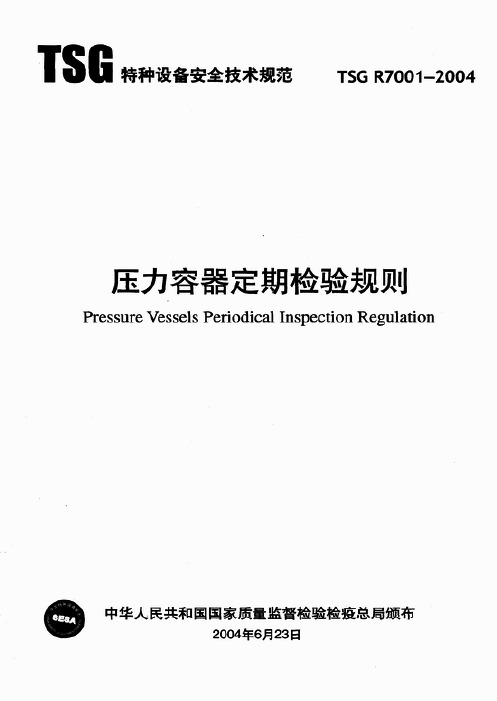
4
维护人员持证上岗情况
格)
附录 2,《压力容器 16 耐压试验报告
10 全面检验报告目录》 17 气密性试验报告
(第 57 页)
18 附加检查、检测报告
16 气密性试验报告 17 附加检查、检测报告
另,附录 3:《耐压试验报告》(第 75 页)最后一栏修改为:
检验机构核准证号:
检验:
日期:
(检验机构检验专用章) 年月日
附件:
《压力容器定期检验规则》(TSG R7001-2004)修改单 (第 1 号,对 2004 年 8 月第 1 版的修改)
序号 1
2
修改条款 第二条(第 1 页第 6 行)
第十七条第(二)项 (第 8 页第 9 行)
原文内容
本规则适用于属于《容规》适 用范围的压力容器的年度检 验和定期检验。其中,在用罐 车(以下简称罐车)、在用罐 式集装箱(以下简称罐式集装 箱)的年度检查和定期检 验,……。 在用医用氧舱(以下简称医用 氧舱)的年度检查和定期检验 应当按本规则附件二《医用氧 舱定期检验要求》进行。
序号 4 5
6 7
修改条款
第二十九条的[σ]t有 关内容(第 17 页第 18 行)
原文内容
[σ]t - 设 计 温 度 下 材 料 的 许 用应力,MPa。
(二十)罐车年度检验工作完 成后,检验人员应该根据实 附件一,第二(二十) 际检验情况,按《压力容器 项(第 31 页第 16 行) 定期检验规则》年度检验的 有关规定做出检验结论,出 具检验报告。
修改后内容
本规则适用于《容规》适用 范围的压力容器的年度检查 和定期检验。其中,在用汽 车罐车、铁路罐车和罐式集 装箱(以下简称罐车)的定 期检验,……。 在用医用氧舱(以下简称氧 舱)的定期检验应当按本规 则附件二《医用氧舱定期检 验要求》进行。
移动式压力容器定期检验附加要求

附件一移动式压力容器定期检验附加要求一、总则(一)本附加要求是在《压力容器定期检验规则》基础上,对移动式压力容器,包括汽车罐车、铁路罐车和罐式集装箱等(以下简称罐车)定期检验提出的附加要求。
(二)本附加要求适用于运输最高工作压力大于等于0.1MPa、设计温度不高于50℃的液化气体、低温液体的钢制罐体(罐体为裸式、保温层或绝热层型式)在用罐车的定期检验。
(三)在用罐车的定期检验分为年度检验、全面检验和耐压试验。
1.年度检验,每年至少一次。
2.全面检验,罐车的全面检验周期按表1-1规定。
表1-1 罐车全面检验周期有以下情况之一的罐车,应该做全面检验:(1)新罐车使用1年后的首次检验;(2)罐体发生重大事故或停用1年后重新投用的;(3)罐体经重大修理或改造的。
3.耐压试验:每6年至少进行一次。
4.本附加要求的各检验项目应当由具有相应检验资格的检验机构,并且由取得相应检验资格证书的压力容器检验人员进行。
检验合格后,检验机构应该在使用登记证上标注检验合格标志,同时在IC卡中写入检验数据。
二、年度检验(一)常温型(裸式)罐车罐体年度检验1.罐车技术档案资料;2.罐体表面漆色、铭牌和标志;3.罐体表面、接口部位焊缝、裂纹、腐蚀、划痕,凹坑、泄漏、损伤等缺陷;4.安全阀、爆破片装置、紧急切断装置、液面计、压力表、温度计、导静电装置、装卸软管和其他附件;5.罐体与底盘(车架或框架)、遮阳罩、操作台、连接紧固件、导静电装置等;6.罐内防波板与罐体连接结构形式,以及防波板与罐体、气相管与罐体连接处的裂纹、脱落等;7.排污疏水装置;8.气密性试验。
(二)低温、深冷型罐车罐体年度检验1.保温层式设有人孔的低温罐车:(1)本附加要求二(一)所要求的罐车罐体年度检验的全部内容;(2)保温层的损坏、松脱、潮湿、跑冷等。
2.绝热层式不设人孔的低温深冷型罐车:(1)罐车技术档案资料;(2)罐体表面漆色、铭牌和标志;(3)用户使用情况:运行记录(装卸频率、异常情况),外壳的结霜、冒汗;(4)真空度;(5)安全阀、爆破片装置、压力表、液面计、温度计、导静电装置、装卸软管和其他附件;(6)管路系统和阀门;(7)气密性试验。
压力容器定期检验规则(TSG.

附件:《压力容器定期检验规则》(TSG R7001-2004)修改单(第2号,对2004年8月第1版及其第1号修改单的修改)1 目录修改内容注:具体页码按照实际进行排列2 正文修改内容3 附件修改内容(1)将附件三《小型制冷装置压力容器定期检验专项要求》及其内容插入第47页;(2)删除原附件三《安全阀校验要求》的全部内容。
(3)附件三的内容如下:附件三:小型制冷装置压力容器定期检验专项要求一、总则(一)本专项要求是在本规则的框架下,对在用小型制冷装置中压力容器定期检验提出的具体要求。
(二)本专项要求适用于以氨为制冷剂,单台贮氨器容积不大于5立方米且总容积不大于10立方米的小型制冷装置中压力容器的定期检验,包括全面检验和耐压试验。
小型制冷装置压力容器主要包括冷凝器、贮氨器、低压循环贮氨器、氨液分离器、中间冷却器、集油器、油分离器等。
(三)小型制冷装置压力容器的年度检查按照本规则第二章的有关规定执行。
全面检验按照本专项要求执行,其中符合本规则第七条(一)、(二)项规定的压力容器,应该进行耐压试验,耐压试验应当满足本规则第四章的要求。
二、全面检验前的准备工作(一)检验人员应该审查以下资料:1. 设计单位资格、设计、安装、使用说明书,主要受压元件设计图样,强度计算书等;2. 制造单位资格、产品合格证书、质量证明书、监督检验证书等;3. 安装资料、安装日期,竣工验收文件、安装监督检验证书等;4. 有关维修或者改造的文件,重大改造维修方案,告知文件,竣工资料,改造、维修监督检验证书等;5. 使用登记证;6. 设备的运行记录;7. 氨液充装时间及氨液成分检查记录;8. 运行周期内的年度检查报告和历次全面检验报告;9. 安全附件校验记录;10. 使用单位安全操作规程、安全管理规章制度、应急预案。
(二)检验人员应该根据资料审查结果和现场的实际情况确定检验项目,制订检验方案,对于同一类型的压力容器,也可以制定通用检验方案。
《特种设备检验检测机构核准规则》(TSG Z7001-2004)

附件1:《特种设备检验检测机构核准规则》(TSG Z7001-2004)第3号修改单(对2005年1月第1版和2007年第1号修改单、2009年第2号修改单的修改)一、正文的修改1.第五条修改为:“国家质量监督检验检疫总局(以下简称国家质检总局)和省级质量技术监督部门为核准机关。
国家质检总局负责受理、审批综合检验机构和无损检测机构,并颁发《特种设备检验检测机构核准证》(以下简称《核准证》);省级质量技术监督部门负责受理、审批其他检验检测机构(含只申请房屋建筑工程及市政工程工地的起重机械和场(厂)内专用机动车辆检验的检验机构),颁发《核准证》。
“特种设备综合检验机构的核准条件分为甲、乙和丙三类。
对获得核准的机构,分别简称为甲类、乙类和丙类机构,其中,乙类和丙类机构只能在省级质量技术监督部门限定的区域内从事检验工作。
”2.第六条第(一)、(二)项修改为:“(一)有独立法人资格(特种设备使用单位设立的检验机构和中央企业设立的检验机构除外);“(二)有与其承担的检验检测工作相适应的检验检测人员、专业技术人员;”3. 第七条修改为:“核准程序包括申请、受理、鉴定评审、审批与发证。
合并重组的机构,按附件3的规定执行。
”4. 第八条和第九条合并为第八条,修改为:“检验检测核准申请采取网上填报方式。
申请机构应当登录负责受理的国家质检总局或者省级质量技术监督部门行政许可业务系统,填写《特种设备检验检测机构核准申请书》(见附件4,以下简称《申请书》),并附以下扫描资料(PDF或者JPG格式)提出申请:“(一)《申请书》封面(加盖申请机构公章);“(二)《申请书》中的“申请核准项目”(机构法人代表人签字,加盖机构公章);“(三)法人资格证明文件“(四)组织机构代码证书“(五)现有核准证书(不适用于首次申请);“(六)特种设备检验检测质量管理体系文件目录(也可为其他电子文本)。
“向国家质检总局提出核准申请的综合检验机构,应当经省级质量技术监督部门同意(在《申请书》封面右下角盖章)。
《压力容器定期检验规则》(TSGR)修改单(第号)

《压力容器定期检验规则》(TSGR)修改单(第号)————————————————————————————————作者:————————————————————————————————日期:2附件:《压力容器定期检验规则》(TSG R7001-2004)修改单(第2号,对2004年8月第1版及其第1号修改单的修改)1 目录修改内容序号原文内容修改后内容1.2 附件三安全阀校验要求附件三小型制冷装置中压力容器定期检验专项要求注:具体页码按照实际进行排列2 正文修改内容序号修改条款原文内容(按照第1号修改单修改后)修改后内容2.1 第二条(第1页)本规则适用于《容规》适用范围的压力容器年度检查和定期检验。
其中在用汽车罐车、铁路罐车和罐式集装箱(以下简称罐车)的定期检验,除符合本规则正文的有关要求外,还应当遵照本规则附件一《移动压力容器定期检验附加要求》的规定。
本规则适用于《容规》适用范围的压力容器年度检查和定期检验。
其中在用汽车罐车、铁路罐车和罐式集装箱(以下简称罐车)的定期检验,除符合本规则正文的有关要求外,还应当遵照本规则附件一《移动压力容器定期检验附加要求》的规定。
小型制冷装置中压力容器的定期检验按照本规则附件三《小型制冷装置中3 / 10压力容器定期检验专项要求》进行。
2.2 第十六条首款(第4页)安全附件的检验包括对压力表、液位计、测温仪表、爆破片装置、安全阀的检查和校验(其中安全阀校验要求见附件三)。
安全附件的检验包括对压力表、液位计、测温仪表、爆破片装置、安全阀的检查和校验(其中安全阀校验要求见TSG ZF001-2006 《安全阀安全技术监察规程》)。
2.2 第十七条第(一)8(第8页)8.使用单位建立了符合附件三要求的安全阀校验站,自行进行安全阀校验。
8.使用单位建立了符合TSG ZF001要求的安全阀校验站,自行进行安全阀校验。
2.3 第二十五条第(十一)2(1)(第15页)(1)安全阀应当从压力容器上拆下,按照本规则附件三“安全阀校验要求”进行解体检查、维修与调试。
压力容器定期检验规则TSGR7002004
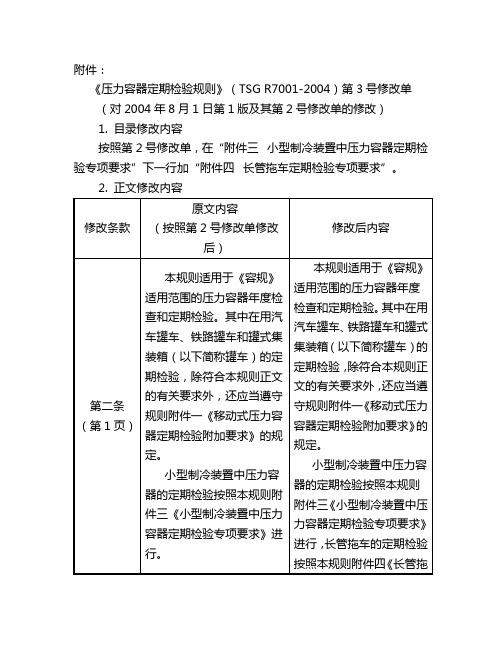
附件:《压力容器定期检验规则》(TSG R7001-2004)第3号修改单(对2004年8月1日第1版及其第2号修改单的修改)1. 目录修改内容按照第2号修改单,在“附件三小型制冷装置中压力容器定期检验专项要求”下一行加“附件四长管拖车定期检验专项要求”。
3. 附件修改内容将附件四《长管拖车定期检验专项要求》及其内容插入附件三《小型制冷装置中压力容器定期检验专项要求》之后,另起一页。
附件四的内容如下:附件四长管拖车定期检验专项要求一、总则(一)本专项要求是在本规则的框架下,对在用长管拖车定期检验提出的具体要求。
(二)本专项要求适用于正常环境温度下(-40~60℃)使用、公称工作压力(标记工作压力)不大于30 MPa、公称水容积(单只气瓶)为500~3000L、用于运输表4-1中规定气体的在用长管拖车年度检查和定期检验。
长管拖车包括气瓶、附件(包括端塞、阀门、管路、快装接头等)、安全附件、气瓶固定装置(框架或捆绑带)、车辆部分等部件。
本专项要求不适用于长管拖车车辆部分的检验。
(三)年度检查和定期检验周期如下:1. 年度检查,每年至少1次,选择在适当时机进行;2. 按照所充装介质不同,定期检验周期见表4-1;3. 定期检验用声发射检测替代外测法水压试验时,充装A类介质的长管拖车定期检验周期为3年,充装B类介质的长管拖车定期检验周期为4年。
表4-1定期检验周期(四)有下列情形之一的长管拖车,应当提前进行定期检验:1. 发现有严重腐蚀、损伤或者对其安全使用有怀疑的。
2. 充装介质中,腐蚀成份含量超过相关标准规定的。
3. 发生交通、火灾等事故,造成对安全使用有影响的。
4. 停用时间超过1年,启用前。
5. 年度检查发现问题,而且影响安全使用的。
(五)当年度检查、定期检验在同一年度进行时,应当依次进行定期检验、年度检查,其中定期检验已经进行的项目,年度检查时不再重复进行。
(六)年度检查可由使用单位或者制造单位进行,定期检验应当由国家质检总局核准的具备长管拖车定期检验专项资格的检验机构进行。
压力容器定期检验规则 第2号修改单
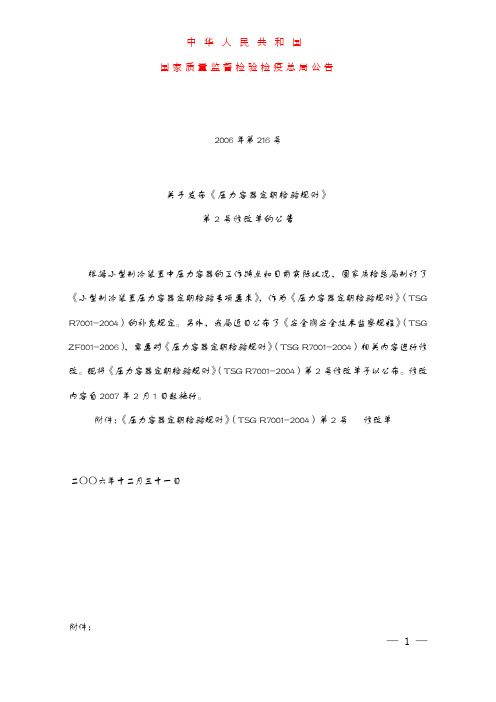
中华人民共和国国家质量监督检验检疫总局公告2006年第216号关于发布《压力容器定期检验规则》第2号修改单的公告根据小型制冷装置中压力容器的工作特点和目前实际状况,国家质检总局制订了《小型制冷装置压力容器定期检验专项要求》,作为《压力容器定期检验规则》(TSG R7001-2004)的补充规定。
另外,我局近日公布了《安全阀安全技术监察规程》(TSG ZF001-2006),需要对《压力容器定期检验规则》(TSG R7001-2004)相关内容进行修改。
现将《压力容器定期检验规则》(TSG R7001-2004)第2号修改单予以公布。
修改内容自2007年2月1日起施行。
附件:《压力容器定期检验规则》(TSG R7001-2004)第2号 修改单二〇〇六年十二月三十一日附件:《压力容器定期检验规则》(TSG R7001-2004)修改单(第2号,对2004年8月第1版及其第1号修改单的修改)1 目录修改内容序号原文内容 修改后内容1.2 附件三 安全阀校验要求附件三 小型制冷装置中压力容器定期检验专项要求注:具体页码按照实际进行排列2 正文修改内容序号 修改条款原文内容(按照第1号修改单修改后)修改后内容2.1第二条(第1页)本规则适用于《容规》适用范围的压力容器年度检查和定期检验。
其中在用汽车罐车、铁路罐车和罐式集装箱(以下简称罐车)的定期检验,除符合本规则正文的有关要求外,还应当遵照本规则附件一《移动压力容器定期检验附加要求》的规定。
本规则适用于《容规》适用范围的压力容器年度检查和定期检验。
其中在用汽车罐车、铁路罐车和罐式集装箱(以下简称罐车)的定期检验,除符合本规则正文的有关要求外,还应当遵照本规则附件一《移动压力容器定期检验附加要求》的规定。
小型制冷装置中压力容器的定期检验按照本规则附件三《小型制冷装置中压力容器定期检验专项要求》进行。
2.2第十六条首款(第4页)安全附件的检验包括对压力表、液位计、测温仪表、爆破安全附件的检验包括对压力表、液位计、测温仪表、爆破片装置、安全阀片装置、安全阀的检查和校验(其中安全阀校验要求见附件三)。
TSG R7001-2004 压力容器定期检验规则
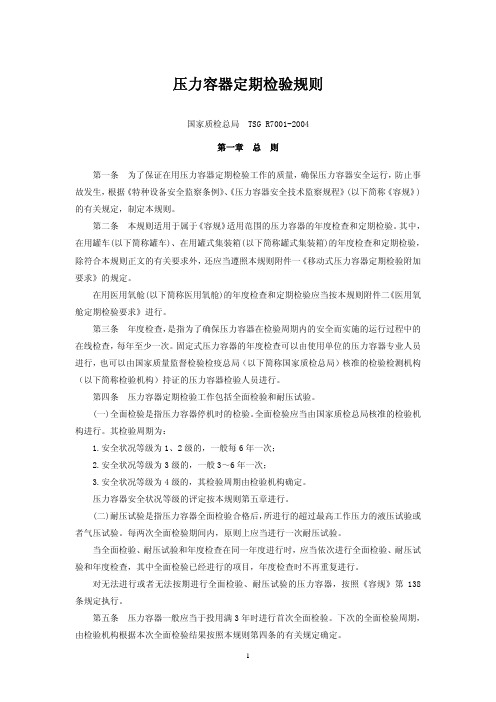
(4)表内弹簧管泄漏或者压力表指针松动; (5)指针扭曲断裂或者外壳腐蚀严重; (6)通旋塞或者针形阀开启标记不清或者锁紧装置损坏。 (二)液位计 1.液位计年度检查,至少包括以下内容: (1)液位计的定期检修维护制度; (2)液位计外观及附件; (3)寒冷地区室外使用或者盛装 0℃以下介质的液位计选型; (4)用于易燃、毒性程度为极度、高度危害介质的液化气体压力容器时,液位计的防止 泄漏保护装置。 2.检查时,凡发现以下情况之一的,要求使用单位限期改正并且采取有效措施确保改正 期间的安全,如果逾期仍未改正应当暂停该压力容器使用: (1)超过规定的检修期限; (2)玻璃板(管)有裂纹、破碎; (3)阀件固死; (4)出现假液位; (5)液位计指示模糊不清; (6)选型错误; (7)防止泄漏的保护装置损坏。 (三)测温仪表 1.测温仪表的年度检查,至少包括以下内容: (1)测温仪表的定期检定和检修制度; (2)测温仪表的量程与其检测的温度范围的匹配情况; (3)测温仪表及其二次仪表的外观。 2.年度检查时,凡发现以下情况之一的,要求使用单位限期改正并且采取有效措施确保 改正期间的安全,如果逾期仍未改正则该压力容器暂停使用: (1)超过规定的检定、检修期限; (2)仪表及其防护装置破损; (3)仪表量程选择错误。 (四)爆破片装置 1.爆破片装置的年度检查,至少包括以下内容: (1)检查爆破片是否超过产品说明书规定的使用期限; (2)检查爆破片的安装方向是否正确,核实铭牌上的爆破压力和温度是否符合运行要求; (3)爆破片单独作泄压装置的(图 1),检查爆破片和容器间的截止阀是否处于全开状态,
tsgr70012004压力容器定期检验规则2004年6月23日发布2004年9月23日实施国家质量监督检验检疫总局发布tsgr70012004压力容器定期检验规则第一章总则第一条为了保证在用压力容器定期检验工作的质量确保压力容器安全运行防止事故发生根据特种设备安全监察条例压力容器安全技术监察规程以下简称容规的有关规定制定本规则
压力容器定期检验规则

TSG特种设备安全技术规范 TSG R7001-2013压力容器定期检验规则Pressure Vessel Periodical Inspection Regulation中华人民共和国国家质量监督检验检疫总局颁布2013年1月16日前言2009年11月,国家质量监督检验检疫总局(以下简称国家质检总局)特种设备安全监察局(以下简称特种设备局)下达修订《压力容器定期检验规则》(以下简称定检规)的任务书,2010年1月,中国特种设备检测研究院(以下简称中国特检院)组织有关专家成立修订工作组,在北京召开第一次会议,讨论定检规修订的原则、重点内容及主要问题,并且就修订工作进行了具体分工,制定了修订工作时间表。
2010年5月,工作组在合肥召开了第二次会议,经过讨论,形成了定检规征求意见稿。
2010年6月,特种设备局以质检特}[2010]31号文征求意见。
2010年10月,工作组根据征求的意见,研究处理形成送审稿。
在修订过程中,特种设备局还多次.与工作组召开专题会议,研讨定检规修订过程中的重大问题。
2010年11月,特种设备局将送审稿提交给国家质检总局特种设备安全技术委员会审议,工作组根据审议意见修改后形成了报批稿。
2013年1月16日,本规则由国家质检总局批准颁布。
本次修订工作的基本原则,与《特种设备安全监察条例》、《固定式压力容器安全技术监察规程》(TSG 80004)和《移动式压力容器安全技术监察规程》(TSG 80005)协调一致;根据5年来的实际使用情况以及行业发展,调整、完善不适应的内容,新增加附件E非金属及非金属衬里压力容器定期检验专项要求;明确定期检验的性质、定位及检验周期的含义,按国家质检总局及信息化工作要求,统一检验结论及结论报告内容;理清使用单位、,检验机构、监察机构的义务;明确检验机构、检验人员的义务与分工;在考虑基本安全要求的基础上,建立基于损伤模式、失效模式制定针对性检验方案的思想,突出检验项目的针对性、有效性、科学性;为新检验检测技术、评定方法的应用,给出渠道;吸纳成熟的科技成果,理清与常规检验方法的关系;方便企业,服务于企业的发展;兼顾国际发展,具有中国特色;安全技术规范与相应标准协调一致,为在用设备检验标准的制定留出接口。
非金属压力容器定期检验细则

非金属压力容器定期检验细则1总则1.1 目的:为了保证非金属压力容器的安全运行,保障人民生命和财产的安全,促进国民经济的发展,根据《特种设备安全监察条例》、《非金属压力容器安全技术监察规程》的有关规定,制定本细则。
1.2适用范围:(一)最高工作压力大于或等于0.1Mpa(表压,不含液体静压),且压力与容积的乘积大于或等于2.5MPa·L的盛装介质为气体、液化气体和最高工作温度高于或等于标准沸点的液体的非金属压力容器,包括石墨制压力容器、纤维增强热固性树脂(以下简称玻璃钢)制压力容器、全塑料制压力容器、移动式非金属压力容器(不包括气瓶)等;(二)与上述非金属压力容器相关的安全阀、爆破片装置紧急切断装置、安全联锁装置、压力表、液面计、测温表等安全附件;(三)非金属压力容器与外部管道或装置焊接(粘接)连接的第一道环向焊(粘接)缝的焊(粘)接坡口、法兰连接的第一个法兰密封面、专用连接件或管件连接的第一个密封面、与压力容器直接相连的吊耳、支架、裙座或其他支承结构的第一连接点及其支承结构;(四)非金属压力容器开孔部分的承压盖及其紧固件;(五)非受压元件与非金属压力容器本体连接的焊接(粘接)接头。
与非金属压力容器组合或联接的金属部件或装置还应符合《压力容器安全技术监察规程》的规定。
2检验工作的主要依据本细则引用标准未注年号的,应使用最新版本。
2.1特种设备安全监察条例2.2固定式压力容器安全技术监察规程TSG R0004-20092.3压力容器定期检验规则TSG R7001—20042.4非金属压力容器安全技术监察规程TSG R0001—20042.5 GB150 钢制压力容器及相关标准2.6 JB/T4730承压设备无损检测2.7HC20640《塑料设备》3检验前准备3.1检验时机非金属压力容器投用后首次全面检验周期为1年。
当定期检验发现有缺陷需要监控使用时,下次内外部检验周期,由检验机构根据内外部检验情况与使用单位协商确定后报当地质量技术监督部门备案。
